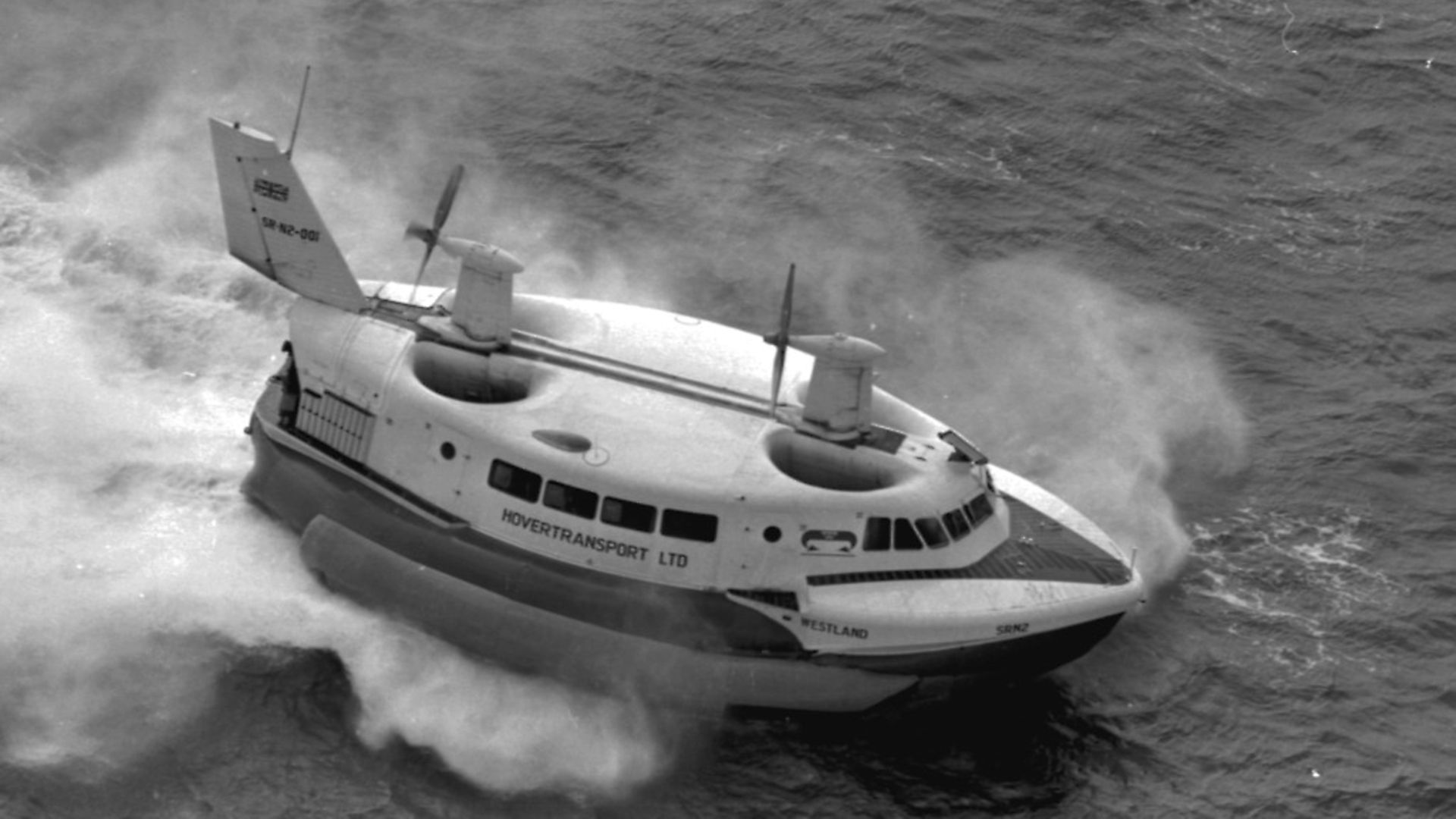
While the Americans and Soviets were putting people in space, the British were developing a technology with a slightly shorter shelf-life.
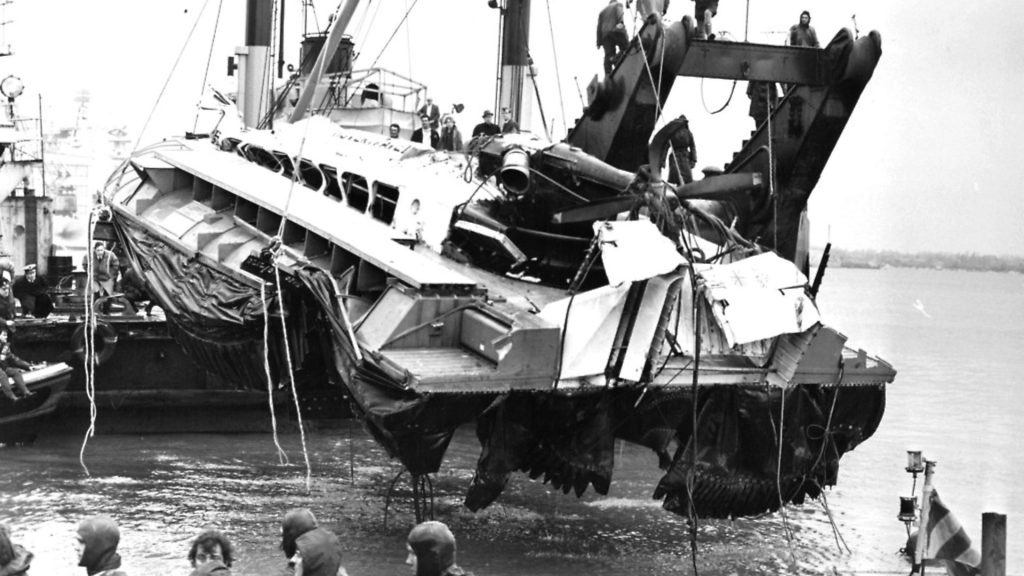
Near the beginning of the 1971 film Diamonds Are Forever, James Bond is heading to Europe on the trail of a sinister smuggling ring. We see him at Dover port behind the wheel of a Triumph Stag and the Bond theme strikes up as 007 accelerates his way below the White Cliffs.
Like the alpha-male he is, he effortlessly speeds into the correct lane on the approach to the docks. As he does so, the music punches into the peak of its brass section crescendo – ‘BA-DA, BA-DA, BA DAH DAH!’
At that very moment, the camera zooms in on the lane signage, which reads ‘HOVERCRAFT’. We then see the Princess Margaret – one of the huge SR.N4 hovercraft which plied the cross-Channel route for more than 30 years – its four Rolls Royce Proteus engines roaring as it accelerates down the slipway into Dover harbour, at the start of its half-hour dash across to the Continent.
Just before this scene, Bond had been flirting with Moneypenny: just afterwards, we see the body of a murdered woman being dragged from a canal in Amsterdam. That’s how the hovercraft sat in the imagination in the late 1960s and early 1970s – they were considered thrilling enough to sit between sex and murder.
Alas, reality almost always gets in the way of imagination. Hovercraft just weren’t that great. They were more about irritated dads and bored kids in Allegros and Cortinas than they were about secret agents in sports cars.
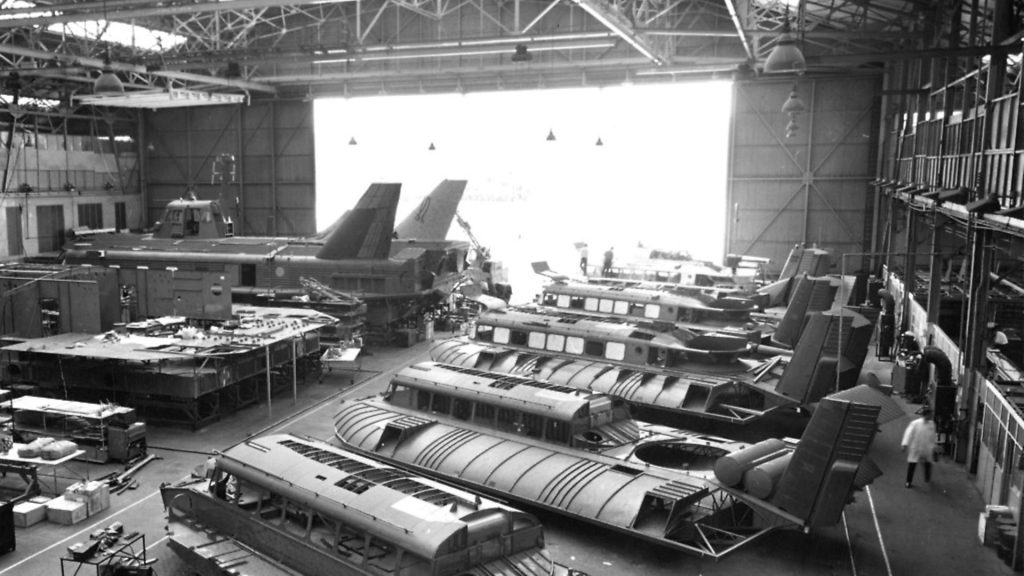
Hovercraft were really noisy, expensive to run and not always easy to control (and almost impossible to control in high winds); they were not that comfortable for passengers (they were sometimes nicknamed the vomit comets and each seat had a sick bag) and couldn’t carry that many vehicles.
There were some advantages – they were fast and they have still have important military, rescue and research uses. But this British invention, like so many of the UK’s technological marvels that came of age in the 1970s – Concorde, Leyland, the revolving restaurant at the top of the Post Office Tower – never stayed the course.
They were all signifiers of a future that never really happened and, like Bond himself, were much more to do with how Britain wanted to see itself – cool, stylish and smart – rather than how it actually was: old, scruffy and strapped.
Old, scruffy and strapped is a pretty accurate description of the Hovercraft Museum in Lee-on-Solent in Hampshire, which is where the Princess Margaret ended up. This museum feels more like a scrapyard than does a heritage centre. Rusting vehicles and odds and ends are stacked up here and there. It’s underfunded, and mostly run on what little money comes through the gate and on the enthusiasm of its volunteers.
None of this makes it a bad museum, it has a superb hodgepodge of a collection. As well as many of the most important British hovercraft of the last 70 years century, it offers all sorts of random silliness: it has the ice cream van that Top Gear turned into a hovercraft and it has the hovercraft from another Bond Film, Die Another Day, which is displayed next to a cardboard cut-out of Pierce Brosnan. And the museum’s volunteers are a well-informed and friendly bunch. It’s scruffy, but well worth a visit.
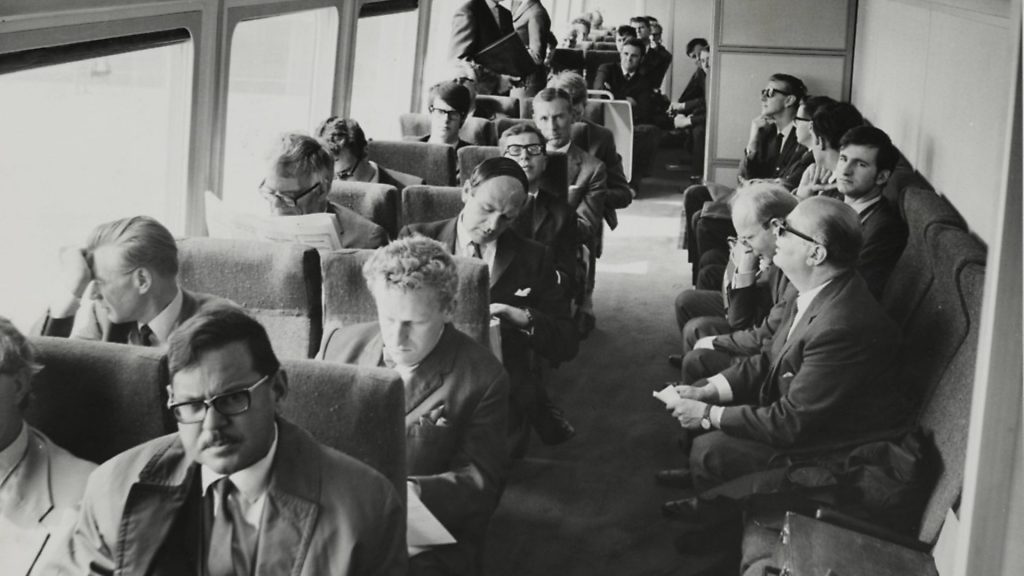
And it is that scrapyard feel of the place that is perhaps its best selling point, because it underlines what the museum’s collection represents: the remnants of a failed future. As it turns out, this hovercraft graveyard was not the Princess Margaret’s final resting place. In March 2018, she was broken up by the museum for spare parts and scrap.
The logic behind this decision was sound; by scrapping her the museum could then repair, and perhaps even get back into working order, the now last remaining SR.N4 – Princess Anne – which is the centrepiece of the collection.
Back in the 1970s, these two SR.N4s – which were the third generation of that particular model – heralded the golden age of hovercraft passenger travel. Then, they were a symbol of promise, not failure. But it was a short golden age and one that, after the first hovercraft were launched in the late 1950s, took a while to arrive.
It’s apt that the Hovercraft Museum is on the shores of the Solent, because it was on this stretch of water that the SR.Ns were developed. Indeed, many were tested at HMS Daedalus, the former Fleet Air Arm base that is now home to the museum.
SR.N stands for Saunders-Roe Nautical and the vehicles were produced by Saunders-Roe, an aero and marine engineering company based on the Isle of Wight, at East Cowes. It was best known, until the hovercraft, for producing flying boats, but after the Second World War, it began what seemed at the time like cutting-edge diversification into new technologies, but in hindsight resembles the bonkers experiments of madcap eccentrics.
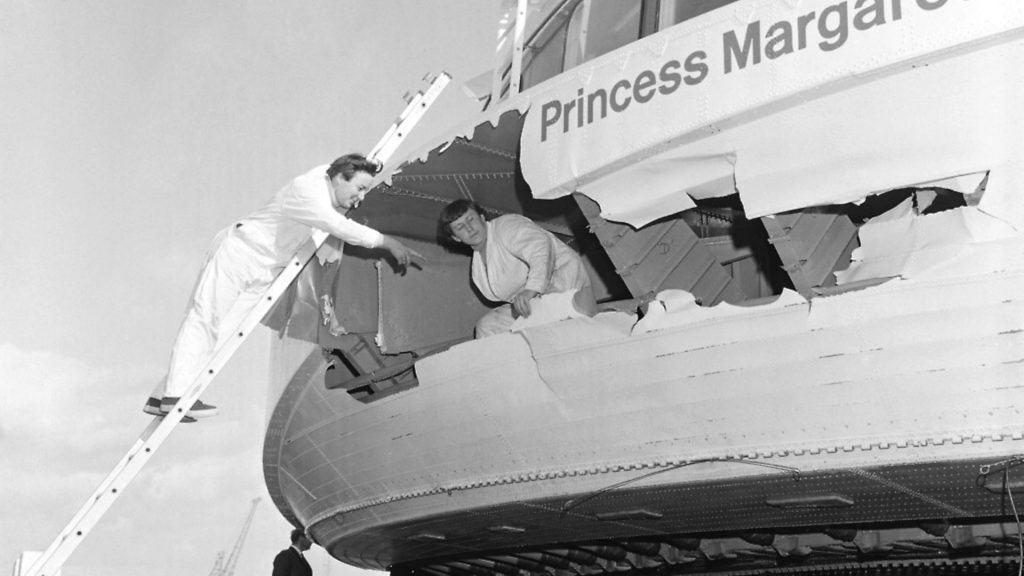
They tried to build a jet-powered flying boat and took part in the UK’s rocket programme – which involved firing rockets from the top of hills in the Isle of Wight. Most eccentrically of all, they planned to build a nuclear-powered cargo submarine.
This view of Saunders-Roe as a mixture of eccentricity and innovation – Dan Dare meets Heath Robinson – is another of those reassuring ways that the English liked to see themselves after the war. This self image was personified on screen by the resourceful, unflappable Q, who produced gadgets for the stylish and sexy 007. It was the cherished British trope of the maverick genius, the amateur inventor in the shed. And it was also manifested in Christopher Cockerell, the man who invented the hovercraft and who did so using cat food cans, coffee tins and vacuum cleaner tubes (or, according to other versions of the story, a hair-dryer).
As usual, reality gets in the way of the popular imagination. Cockerell was not really a madcap inventor beavering away at his lunatic schemes in a shed. He was a highly-skilled engineer who had worked for Marconi both before and during the Second World War, helping to build and perfect the radar technology that did so much to end that conflict.
But there was a bit of the madcap about him. In 1950, Cockerell left Marconi to manage a boatyard on the Norfolk Broads. While there he began to experiment with the idea that a cushion of air could support a vehicle. This was not a new idea – in the 19th century the shipbuilder Sir John Thornycroft had experimented with using air to reduce friction, but Cockerell came up with a novel solution to the problem of how to maintain traction without friction.
The biggest difficulty that frictionless travel faces is to do with control and steering and braking. Also, pumping huge amounts of air under a vehicle uses a vast quantity of energy because the air instantly escapes.
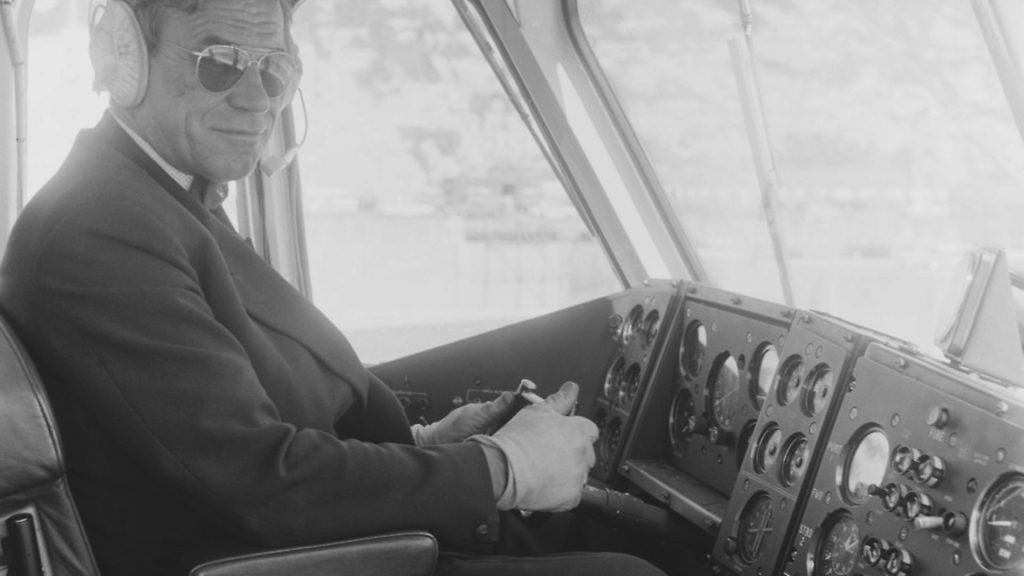
Cockerell found that by placing a smaller can (specifically, one for Kit-e-Kat cat food) inside a larger one (for coffee) and then blowing air into that larger one, he could create what he called a ‘momentum curtain’ as the air pushed its way around the smaller receptacle.
Cockerell believed that this rapid flow of downward-directed air around the edge of a hull of a vehicle would provide the same amount of lift as just pumping air underneath the entire vehicle. Moreover, these focussed jets of air provided the pilot of the vehicle with a greater degree of control when it came to steering the vehicle. Cockerell’s hovercraft does not so much ride on a cushion of air, rather, it rides on a contained ring of air, a ring that is contained in a ‘skirt’, from where air does not escape. This uses less energy and allows for greater control. Cockerell struggled to get his vehicle idea taken seriously by the government. Supposedly, the Royal Navy considered it to be a plane, and the Royal Air Force considered it a ship. But in 1958 he teamed up with Saunders-Roe which, because the company liked odd ideas, was probably the perfect partner for making his idea real. The firm began to develop the first working hovercraft.
There were a number of difficulties in this development stage, mostly to do with powering and steering the craft (these two issues would dog the hovercraft for the rest of its commercial life). The third main problem was managing the skirt, the large rubber sheeting that trapped the air in the ring beneath the vehicle, acting as the larger, coffee can.
But then, on June 11 1959, the vessel – named SR.N1 by the manufacturers and ‘The Flying Saucer’ by the media – made its debut. The idea was for a press launch showing reporters the hovercraft working on land. But the newspapermen, in a rush of enthusiasm, demanded it should also head out across the water.
The test crew acquiesced, and this noisy, odd-looking disc, took to the waters of the Solent, where it tore up and down in front of the watching crowds. It was a triumph for the designers, and reported up in the papers as such. Then, a few weeks later, on July 25 – a date which just happened to be the 50th anniversary of Bleriot’s first flight across the Channel – Cockerell and test pilot Peter ‘Sheepy’ Lamb took the SR.N1 to France and back.
The appearance of this new technology came at the end of a decade where Britain had become self-conscious about the fact that it was a nation in decline. The pumped-up pomp of the coronation of Elizabeth II and the championing of the Commonwealth – essentially a relaunch for a collapsing empire – were both semi-conscious attempts to make the Brits feel good about themselves, as the country’s global political clout was eclipsed by the USA and USSR.
The Brits did try to keep up with the superpowers – for example by launching rockets off the Isle of Wight (and in the Australian desert; the UK’s rocket programme wasn’t entirely like something from an Ealing film) – but the game was mostly up. Compared to its world-shaping past, Britain’s present and the future looked a bit threadbare. Yet the UK did now have one thing that Washington and Moscow didn’t: the hovercraft. At times it felt as if this peculiar technology was carrying the weight of a nation’s expectations on its not particularly reliable inflatable skirt.
When the first commercial hovercraft route was launched in 1962, it was compared to Telstar, the US satellite launched the same year. The ‘hovercoach’ service ran from Rhyl, in north Wales, across the mouth of the Dee estuary to the Wirral peninsula. It was supposed to carry 24 passengers, 12 times a day. They would travel at 70mph, and the journey would take 30 minutes. But unlike Telstar, the Rhyl hovercoach fell flat. It ran on only 19 days of its 54-day trial period, and only managed the full 12 daily trips twice. Six months after the service began, both engines on the hovercraft gave out and it had to be towed back to port. That was the end of that route.
Other services failed in quick succession. There was one on the Bristol Channel, another along the Clyde and another between Largs and Cumbrae. All ended in ignominy because the technology just wasn’t durable enough, and the machines were noisy and expensive.
It wasn’t until the launching of the Hovertravel route across the Solent, between Ryde and Southsea, in 1965, that the commercial hovercraft began to work. The service (albeit in a reduced form) still runs today; the Solent is not only the home of the Hovercraft Museum and birthplace of the technology, it is the only place left where the vehicle is still used as for commercial travel.
But the real triumph of the commercial hovercraft came with the cross-Channel routes – such as the one caught by James Bond on his way to track down his foes in 1971 – though triumph is perhaps not quite the correct word. The story is messier than that.
The SR.N4s were on the whole, robust enough to cope with the busy, unpredictable waters between England and France – although passengers often needed to be fairly robust themselves, when the surface-skimming craft ran into choppy seas.
The first generation of the craft were 40m in length and could carry 254 passengers and 30 cars. Two services started operating, one run by Seaspeed that departed from Dover and a second, from Hoverlloyd, that operated out of Pegwell Bay, near Ramsgate. Rather thrillingly this second route crossed the Goodwin Sands – the giant semi-submerged sandbank that had been wrecking ships off the Kent coast for centuries.
Between them, these two companies ran six SR.N4s – Princess Anne, Princess Margaret, Swift, Sure, Sir Christopher and the Prince of Wales.
There was always something political about the use of these SR.N4s, which were the largest commercial hovercraft ever produced.
This politicisation was there in some of their names, and in their collective name – they were called the Mountbatten class, after Lord Louis Mountbatten, who – among his other roles – was governor, then Lord Lieutenant of the Isle of Wight.
Mountbatten would regularly travel by hovercraft from near his Hampshire estate at Broadlands to the island. He would champion the Isle of Wight-based hovercraft industry until his murder by the IRA in 1979. Such royal connections – and the royalist nomenclature for some of the vehicles – are very much of the age, and the sense of the UK clinging to something grand in the face of decline. It was in that spirit, in 1968, that Princess Margaret launched her namesake.
But the commercial viability of this technology was always in doubt. Cockerell may have worked out a more efficient method of lifting the vehicle – but they still required a huge amount of fuel. The simple truth was that it cost far more to move a passenger across the Channel in a hovercraft that it did on a ship. But, as New Scientist put it in 1975: ‘The 1968 decision to put the SR.N4 on the Dover-Boulogne route was largely political – the motivation was to give a conspicuously British technology a helping hand.’ This British machine had to be seen to succeed both commercially and technically. And at first, it struggled with both.
Three months after it opened, the service was suspended while the vehicles were refitted to fix various technical difficulties. The cancellation rate in 1968 was 30% – so passengers booked on the service had only about a one in three chance of getting to France on time. But slowly and steadily these technical problems were resolved and by 1973 that cancellation rate was down to 5%.
The real problem was commercial viability, though. If this business was to work it became apparent that even these giants were going to have to be even bigger. Thy would have to fit in yet more people and cars if they were to pay their way. Spiralling fuel prices forced the issue. So in 1972, the SR.N4s were enlarged, so as to carry more people and more vehicles. And then, in 1976 Princess Anne and Princess Margaret underwent further expansion (they were chopped in half and a new section was slotted in) to allow them to carry 416 passengers and 60 cars each.
This was it. Finally, after years of technical problems and commercial difficulties, the late 1970s promised to usher in a golden age of hovercraft travel. These stretched giants operated this high-yield, rapid transport system which actually worked.
But it didn’t last. In 1980, Hoverlloyd, which in the 1970s had enjoyed a 25% share of the cross-Channel market, saw a punishing 128,000-person decrease in passenger numbers. Seaspeed were also struggling. The main reason was the recent introduction of huge passenger ferries, plying the same routes, although the country’s wider economic difficulties didn’t help.
So, in 1981, Hoverlloyd and Seaspeed merged and became Hoverspeed. The terminus at Pegwell Bay was closed. It lay derelict for years before being demolished, though industrial archeologists who are drawn to failed enterprise, can still find the remains of the hovercraft pad, car marshalling area and approach road.
During the 1980s, the cross-Channel hovercraft industry staggered on through various buy-outs and restructuring programmes. In 1986, a new form of rapid transport arrived with the SeaCat hydrofoils which were added to the Hoverspeed fleet, and by the mid-1990s, the two Princesses were the only hovercrafts still running.
By then, another transport rival was already foreshadowing the end. The opening of the Channel Tunnel, and the end of duty-free sales, finally sank the cross-Channel hovercraft.
The last service ran on October 1, 2000, 16 months to the day after the death of Christopher Cockerell and a few weeks after the death of the machine’s pioneering test pilot ‘Sheepy’ Lamb.
There is much more to the history of the hovercraft than just its use as a commercial vehicle. The vehicles are still used by the military worldwide. The status of ‘world’s largest hovercraft’ was taken from the SR.N4 IIIs in the 1980s by the Russian ZUBR class, a 57m monster capable of carrying three tanks (or hundreds of troops) at speeds of up to 60 knots. The US military had closely monitored Cockerell’s technology in the 1950s and 1960s and used hovercraft during the Vietnam War on river patrols and in some raids on Viet Cong areas. The Landing Craft Air Cushion (LCAC), which can deliver a 60-tonne payload onto a beach, is still used by the US Navy today.
Various other countries have also found military uses for the machines through the decades. There is a story, probably apocryphal, that Margaret Thatcher asked Saddam Hussein if the British could borrow Iraq’s military hovercraft during the Falklands War. They are also useful rescue craft, especially in coastal areas with mud flats and sandbanks. Morecambe RNLI has a hovercraft, for instance.
But the story of the commercial hovercraft is the story of a failed technology. If you visit the Hovercraft Museum, you can walk about the Princess Anne with its cavern-like car deck, its old adverts for duty free and rows of empty seats, with their dull brown nylon moquette and vinyl-covered headrests.
This ghost ship (or should that be ghost plane?) represents a technology that – while spellbinding and revolutionary – was never quite fit for purpose, and a giant act of national wish fulfilment for a wish that never came true. Britain is littered with heritage parks and museums, and it often feels as if the weight of its past – war and empire, industrialisation and class – is constantly holding the country back. But there is something distinctive about the Hovercraft Museum, this graveyard of a place, where you can still see the chopped up remains of the Princess Margaret. What this museum does, albeit unintentionally, is display a Britain that was not quite as clever and innovative as it thought it was. There’s much to be said for that sort of honesty.
We were not as clever as the Soviets and the Americans with their rockets, or the Germans with their BMWs and Audis, or the Japanese with their microchips and electronics. We weren’t even as clever as the French with their TGV. In the same way that Bond went from Sean Connery in an Italian suit to Roger Moore in a safari suit, the hovercraft is, essentially, the story of British decline.










